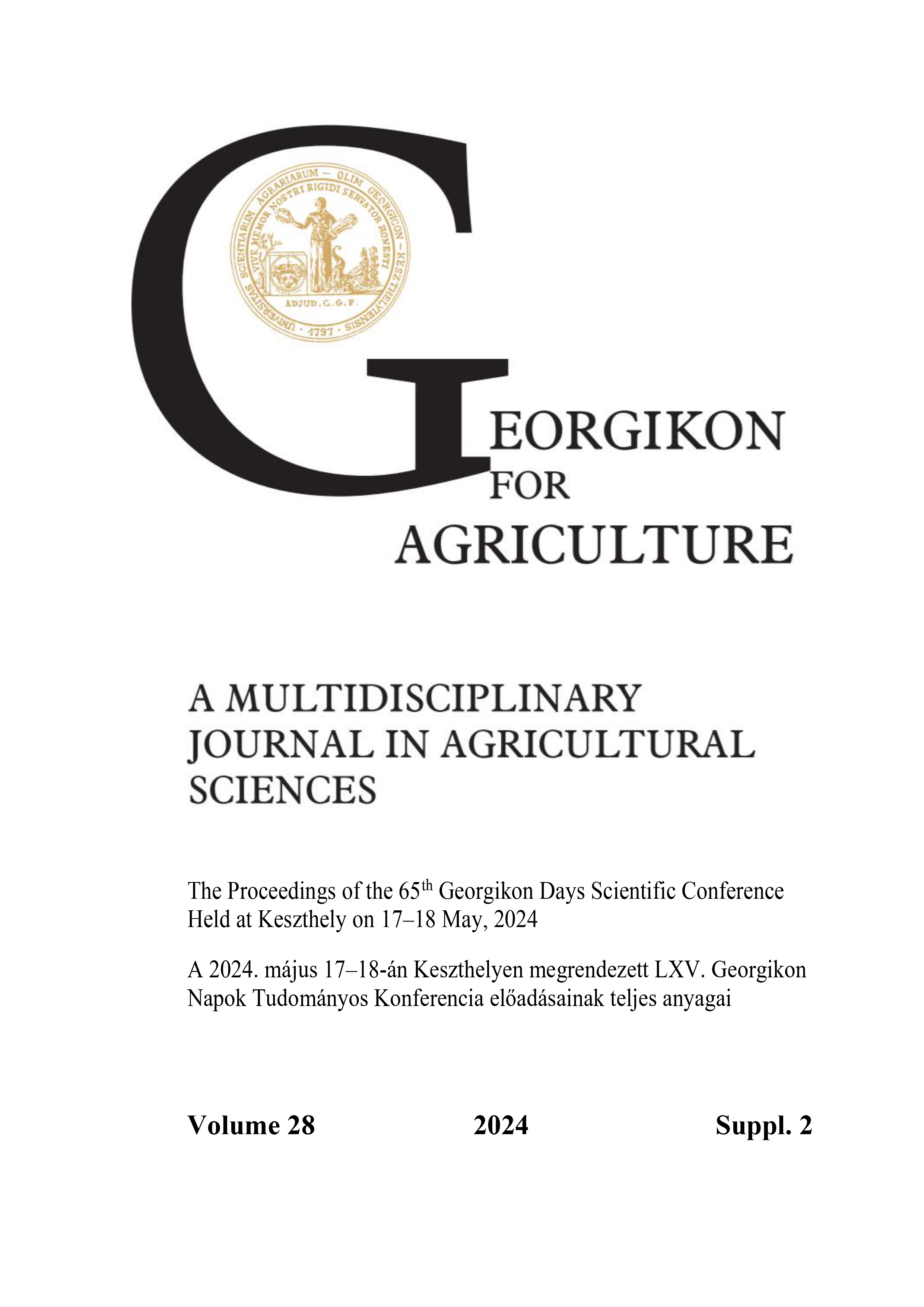Processing Tomato Seedling Cultivation with Water Deficit
Keywords:
processing tomato, seedlings, irrigation, water retentionAbstract
Due to global climate change, the risk of outdoor plant cultivation is raising. In the previous centuries floods and drainage were the main problems in the Danube -Tisza interfluve, but nowadays there are the frequent, long periods of drought. We must focus on water retention and water conservation in our cultivation technology. Among the products that affect the water balance of the soil, we chose Water Retainer® (WR), which was developed in Hungary. The purpose of our research was to establish how the application of WR affects the amount of irrigated water and the growth of seedlings. At the end of the seedling cultivation period, seedling height, number of true leaves and stem diameter were measured. After the measurement, the remaining seedling was planted in open field, and did not receive any further treatment. During the harvest period, we measured the number and weight of ripe, half ripe, green and diseased berries. Samples from ripened berries were taken to measure the refraction. The plants in the WR treated seedling trays were successfully grown using half as much irrigation water. The number of green and half ripened berries was significantly lower in the planted plots of plants that received 100% irrigation during the seedling cultivation.
References
Davies, J. N., Hobson, G. E. 1981. The constituents of tomato fruit – the influence of environment, nutrition and genotype. CRC Critical Reviews in Food Science and Nutrition. 15 (3), 205–280. https://doi.org/10.1080/10408398109527317
Giovannucci, E., Ascherio A., Rimm E. B., Stampfer, M. J., Colditzand, G. A., Willtt, W.C. 1995. Intake of carotenoids and retino in relation to risk of prostate cancer. Journal of National Cancer Institute. 87 (23), 1767–1776. https://doi.org/10.1093/jnci/87.23.1767
Helyes, L. 1999. A paradicsom és termesztése. SYCA Szakkönyvszolgálat Budapest
Helyes, L. 2013. Gondolatok és eredmények az ipari paradicsom termesztéséről. Agrofórum. 24 (2) 32–36.
Helyes, L. 2015. Ipariparadicsom és fenntarthatóság. Kertészet és Szőlészet. 64 (3) 14–15.
Helyes, L., Dimény, J., Bőcs, A., Schober, G., Pék, Z. 2008a. The effect of water and potassium supplement on yield and lycopene content of processing tomato. Acta Horticulturae. 823, 103–108 https://doi.org/10.17660/ActaHortic.2009.823.11
Helyes, L., Pék, Z., Lugasi, A. 2008b. Function of the variety technological traits and growing conditions on fruit components of tomato (LycopersiconLycopersicum L. Karsten) Acta Alimentaria. 37 (4) 427–436. https://doi.org/10.1556/AAlim.2008.0010
Ho, L. C. 2003. Genetic and cultivation manipulation for improving tomato fruit quality VIII International Symposium on the Processing Tomato. Acta Hortic. 613, 21–31. https://doi.org/10.17660/ActaHortic.2003.613.1
Jauregui, J. I., Lumbreras, M., Chavarri, M. J., Macua, J. I. 1999. Dry weight and brix degree correlation in different varieties of tomatoes intended for industrial processing. Acta Hortic. 487, 425–430. https://doi.org/10.17660/ActaHortic.1999.487.69
Lapushner, D., Bar, M., Gilboa, N., Frankel, R. 1990. Positive heterotic effects for °Brix in high solid F1 hybrid Cherry tomatoes. Acta Hortic. 277, 207–212. https://doi.org/10.17660/ActaHortic.1990.277.23
Macua, J. I, Lahoz, I., Arzoz, A., Garnica, J. 2003. The influence of irrigation cut-off time on the yield and quality of processing tomatoes. Acta Horic. 613, 151–153. https://doi.org/10.17660/ActaHortic.2003.613.18
Mahakun, N., Leeper, P. W., Burns, E. E.: 1979. Acidic constituents of various tomato fruit types. Journal of Food Science. 44 (4) 1241–1244. https://doi.org/10.1111/j.1365-2621.1979.tb03489.x
Milotay P., Schmidtné Szantner B., Molnár-Mondovics Á., Kis A., Tóth-Horgosi P. 2016. Paradicsom vízoldható szárazanyag tartalmának változása két eltérő évjáratban. XXII.. NövénynemesítésiTudományos Nap, Abstr. 104. ISBN 978-963-396-085-1.
Pék, Z., Szuvandzsiev, P., Neményi, A. Helyes, L. 2014. Effect of season and Irrigation on Yield Parameters and Soluble Solids Content of Processing Cherry Tomato. Acta Hortic. 1081, 197–202. https://doi.org/10.17660/ActaHortic.2015.1081.24
Ragab M. E. et al. 2019 Effect of irrigation systems on vegetative growth, fruit yield, quality and irrigation water use efficiency of tomato plants (Solanum lycopersicum L.) Grown under water stress conditions. Acta Scientific Agriculture. 3 (4) 172–183. https://actascientific.com/ASAG/pdf/ASAG-03-0409.pdf
Veit-Kohler, U., Krumbeinand, A., Kosegarten, H. 1999. Effect of different water supply on plant growth and fruit quality of Lycopersicon esculuntum. Journal of Plant Nutrition and Soil Science. 162 (6) 583–588. https://doi.org/10.1002/(SICI)1522-2624(199912)162:6<583::AID-JPLN583>3.0.CO;2-P
Warner, J., Tan C. S., Zhang, T. Q. 2007. Water management strategies to enhance fruit solids and yield of drip irrigated processing tomato. Canadian Journalof Plant Science. 87 (2), 345–353. https://doi.org/10.4141/P06-031
Waterandsoil 2020. https://www.waterandsoil.eu/how-it-works. People and Nature, 2 (2) 350–368. http://dx.doi.org/10.1002/pan3.10088
Downloads
Published
Issue
Section
License
Copyright (c) 2024 Barbara Schmidt-Szantner, Tibor Gáll, Ágnes Molnár-Mondovics, Rita Tömösközi-Farkas, Zoltán Pék

This work is licensed under a Creative Commons Attribution-NonCommercial-NoDerivatives 4.0 International License.
Cikkre a Creative Commons 4.0 standard licenc alábbi típusa vonatkozik: CC-BY-NC-ND-4.0. Ennek értelmében a mű szabadon másolható, terjeszthető, bemutatható és előadható, azonban nem használható fel kereskedelmi célokra (NC), továbbá nem módosítható és nem készíthető belőle átdolgozás, származékos mű (ND). A licenc alapján a szerző vagy a jogosult által meghatározott módon fel kell tüntetni a szerző nevét és a szerzői mű címét (BY).




